Chris Baty's Blog, page 189
May 9, 2014
"Creative Ideas Aren't Enough—You Need the Courage to Act On Them."

IDEO founder David Kelley, and his brother Tom Kelley have written Creative Confidence : an inspiring book that details the power of unleashing the creative potential that lies within each of us. Former intern Hannah Rubin interviewed Tom about how creative confidence can change your life:
Hannah: Firstly, what is Creative Confidence? And how does it relate to the average person?
Tom Kelley: Creative confidence is the natural human ability to come up with breakthrough ideas and the courage to act on them. We all have more creative potential waiting to be released. Since everyone was creative at some point in their lives (consider kindergarten), the challenge is more about unlocking creative potential than generating it from scratch.
When people become confident in their own creative ability, it changes everything. Think about how much more positive your life is when you see yourself as a creative person. When you have creative confidence, you can change things. You can do what you set out to do.
You’ve mentioned your ideas about the difference between creativity and talent. Tell us more:
Tom: When people say ‘I’m not creative,’ in many cases it comes from the misperception that “real creativity” just comes naturally—without any effort. Yet no one, including Mozart, sat down at the piano the first day and wrote sonatas. Right? Even to be in the medium range of expressing your piano abilities takes work. There’s technique to it. There’s process. There’s a methodology that you have to practice.
Creative ideas aren’t enough—you also need the courage to act on them. Be brave. Be persistent. The world needs your creative confidence.
How do you think National Novel Writing Month ties into your project to get people to feel more confident creatively?
Tom: Creative confidence is like a muscle—it can be strengthened and nurtured through effort and practice. In my experience, the best way to do that is through action, one step at a time.
NaNoWriMo strengthens creative confidence, because it enables people to surprise themselves with how creative they really are.
What are some other sorts of things that people can do to recharge the creative parts of themselves that don’t often get to see the sunlight?
Tom: A good portion of the book’s message is to do more exploring. Just constantly try new things in a low-risk way. Or look for ways to reframe a problem that you’re working on, ways it might be solved in a different or a better way. Some of your experiments aren’t going to work—like trial and error. But be in the mode of ‘I’m the kind of person that tries stuff, because in the process I discover ideas that work and succeed and blossom and grow.’
— Hannah
May 7, 2014
5 Surprising Truths About Book Marketing
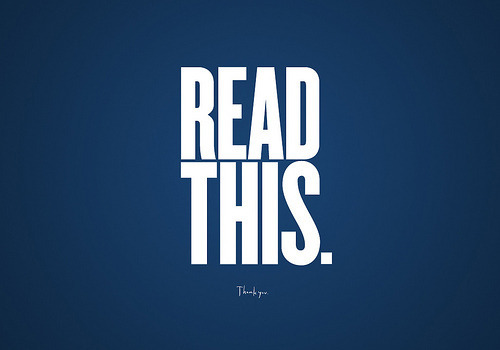
With your first draft firmly in place, your thoughts may turn towards revision and, eventually, getting an audience for your book. It can all seem like unfamiliar terrain after weeks spent with characters and a plot you know like the back of your hand. Today Tim Grahl, who helps authors like Hugh Howey grow their audiences, illuminates the road ahead:
It’s hard to find your place as a writer in this new world of marketing. None of us want to be the self-promotional, in-your-face type of person that is desperately trying to get someone—anyone!—to buy a copy of your book. So before they even get started, many authors decide marketing isn’t for them and their books languish as a result.
Here’s the thing: after working with over 100 authors and studying many more, I’ve found five surprising truths about what it really means to successfully market your books.
1. The definition of marketing has changed.
Most of us think of television commercials, pop-up ads or the used car salesman when we think of marketing. Fortunately, that’s all changed. In today’s world, the old way of doing it is out. Marketing isn’t sleazy tactics, tricking people into buying or intrusive self-promotion.
The new definition of marketing is this: “Creating long-lasting connections with people.”
That’s it. If you connect with readers and then work to maintain those connections, book sales will naturally follow.
2. It’s about people, not numbers.
The most successful authors I know focus on helping people. Just take a few minutes to peruse best-selling author Hugh Howey’s site, and you’ll see he’s dedicated to the writing community and helping authors succeed. You’ll also see he’s dedicated to his reader’s happiness. He doesn’t care whose books they buy or how they buy them, he just wants people to enjoy reading.
Marketing isn’t about shoving more sales through the pipeline, it’s about helping people find happiness in books.
3. Introverts can do it.
I recently received this in an email from an author:
“Marketing seems to come easy for authors like you but I just don’t think an introvert like me can do it.”
If only they knew. Put me in a room of more than two strangers and I’m the guy standing against the wall looking at my phone and feeling like everyone can sense the anxiety rolling off of me.
Luckily, for you and me, marketing isn’t just for the extroverts among us. In fact, the great thing about all these new online tools is that you can do all of the marketing from the comfort of your own home. I’ve sold my own book and helped lots of authors sell their book barely every leaving my hometown of Lynchburg, VA.
4. Social media doesn’t sell books.
I’ve personally run the book launch campaigns for many top, New York Times best-selling books. Several of these authors had huge followings on social media. One in particular had over 200,000 followers on Twitter.
However, when I actually tracked sales, even a Twitter following of over six figures barely sold any books. If you think about how people interact with Twitter, it’s not surprising. They’re following thousands of people and just randomly checking in to the fire hose of information coming their way.
Facebook, Pinterest and the other social media platforms are the same. So I encourage authors not to waste a lot of time trying to build a huge following for their Twitter feed or Facebook page, and instead, focus on building an email list. Email, by far, is the best way to communicate with your fans. If you’d like to learn more about how to use email as an author, I wrote an in-depth post about it here.
5. It’s fun.
This is often the most surprising things for new authors. Marketing seems scary and loud and manipulative. And we’re not just trying to sell some widget that rolled off the assembly line on the other side of the world. We’re selling something we’ve painfully extracted from our soul and put onto paper for all the world to see.
But I promise you, if you focus on connecting with readers, helping them find happiness in books and then communicating with them in an ongoing way, you’ll find you actually enjoy it.
We need your writing. The more people that read your words, the better this world will be. So embrace the new world of marketing and share your work with more people.
Tim Grahl is the president of Out:think, a firm that helps authors and writers create their platform, connect with readers and sell more books. He works with top best selling authors such as Daniel Pink, Chip and Dan Heath, Hugh Howey, Dan Ariely, and Pamela Slim.
Top photo by Flickr user Brett Jordan.
May 5, 2014
Great Writers Never Stop Writing: Establishing the Cycle

Camp NaNoWriMo may be over, but creative inspiration doesn’t stop. Maintaining a writing habit takes as much care as revising your first draft… today, R.M. Prioleau, an active NaNoWriMo participant and independently published author share her tips for building a writing and editing rhythm:
If you are one of the many who have won this year’s Camp NaNoWriMo, then congratulations! You have done the majority of the hard work—getting your book out on paper. But don’t think it stops there… especially if you are considering publishing your great work of art. Sure, you’ve managed to write ‘The End’, but the manuscript is far from being officially done. This is the first draft. And you’ll need to be prepared to spend a lot of time with that first draft.
But before you do anything, put that first draft away. Seriously. The longer the better. While you’re letting that manuscript simmer, start on your next book (just in time for July’s Camp NaNoWriMo!). After you’ve allocated enough time away from your first manuscript, take it out and read through it again with fresh eyes and a fresher mind. You’ll cringe, squirm, and think, ‘This totally needs to be reworked before I can even think of letting the world read it’.
Remember, this is your first draft. A good piece of literature should be revised at least a few times. You shouldn’t rush perfection. This is your baby, and you want it to be as well-raised as it can be. First draft revisions can be a pain, but they’re necessary. Sometimes revision requires entire scenes and chapters to be rewritten. For me, revision of a first draft can take upwards of 2-3 months.
After you’ve revised, self-edited, and rewritten to your heart’s content, you should let others read and critique it. This is where critique groups are essential. The more fresh eyes on your work, the greater the chance someone will find something wrong with it. And I always say, “Better my editor and critique partners find the flaws in my story than a reader’. Once your book gets into readers’ hands, you’ve made a statement. Set an expectation. And there’s no greater critic than the readers.
Also, I can’t stress enough the importance of finding a good editor! Please do not breeze over this step. Readers will know when a book hasn’t been properly edited, and that can haunt you as an author for a very long time. Editors are invaluable. Find the right one for you.
By the time you reach that phase, you’ll probably have had a good four months behind you working with this one manuscript. Perhaps longer. Taking your time is always good, because it means you’re paying attention to the fine details. But trust me, patience pays off in this game. Your new readers will thank you for it.
And by the time you have your fully-polished manuscript, it’s time to publish! And then guess what? The cycle begins again. A new story awaits to be told. Remember, a great writer never stops writing.
So keep writing!
R.M. Prioleau is a game designer by day and a dangerous writer by night. Since childhood, she’s continued discovering new ways to expand her skills and creativity as she delves into the realm of literary abandon. R.M. is a NaNoWriMo enthusiast who has been active in the worldwide writing community since 2009.
Top photo by Flickr user roland.
May 2, 2014
"Write something true. Write something frightening. Write something close to the bone. You are on..."
Any way that you can tell that story more truly, more vividly, more you-ly, is the right way.”
- Catherynne M. Valente, on sharing your story with the world.
April 30, 2014
It’s the last day of Camp NaNoWriMo, the April 2014...
It’s the last day of Camp NaNoWriMo, the April 2014 edition, and we’re going out with a bang! We’re hosting a Virtual Write-In today at 11:00 AM PDT, with a few final word sprints to get you across the finish line, and some hardcore celebration. There may or may not be a dance party involved.
Hope to see you there!
April 29, 2014
Camp Pep: No Metaphors, All Business
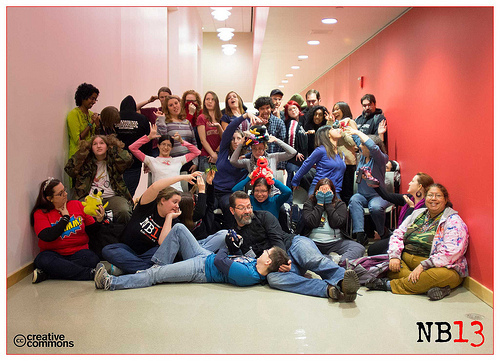
There’s just a little bit of time left in April, but Camp NaNoWriMo isn’t over yet! For everyone still writing, imagining, or recovering, Chris Angotti, director of programs, delivers some pep (Above: The NaNo Boston crew. Photo taken by travlarkboston.):
This isn’t going to be one of those Camp pep talks with a bunch of metaphors about climbing mountains, rowing boats, or evading sasquatch. We love our outdoorsy symbologies, but I’ll bet—in these waning hours of April—they’re not what you need right now.
It’s time to stop messing around and get serious. Like, “Why do none of these freaking dictionaries include the plural of ‘sasquatch’?” serious.
So you, with the few (or several) thousand words to go:
You’ve made it a long way. We’re proud of that and we hope you are, too. It would be straight-up crazy for you not to mash on the gas and finish this race. (See how far away we are from camp metaphors?)
Stay up late, get up early, call out of work, drop the kids off at Chuck E. Cheese with $60 in tokens—whatever it takes for you to hit your goal and type “The End.”
And you, with those scant pages written the first week of April:
Okay, you haven’t made it so far. But you had an idea, and probably a good one. That puts you in the tiny, bright creative sliver of this world, and we want you to stay there.
Spend these last days working just a little more. Ignore the goal if you need to, and just focus on moving your story along. It’ll get to where it needs to be eventually, I promise.
Finally you, the one who’s already celebrated an April triumph:
Good job. Now, we’ve got an important assignment for you:
Cheer on your fellow Campers. Take to your cabin, to Facebook, to Twitter, to the NaNoWriMo forums and say, “I did this and you can, too! We’re in this together, and I’ll even send you that $60 for your kids to use at Chuck E. Cheese.” (Okay, maybe not the last part.)
Our programs work because of this community—the thousands of writers sharing the same challenge and rooting each other on. We’re all part of that little sliver I mentioned, and we owe it to one another to keep shining.
The metaphors we use in our pep talks don’t matter. It’s the love, the process, and the people that really count.
Let’s finish together.
Chris Angotti
Official word-count validation has begun! Make sure to claim your win (and some awesome winner goodies) by following these steps.
April 28, 2014
Ask An Author: "How do you escalate conflict, and then wrap up the plot and subplots towards an ending?"
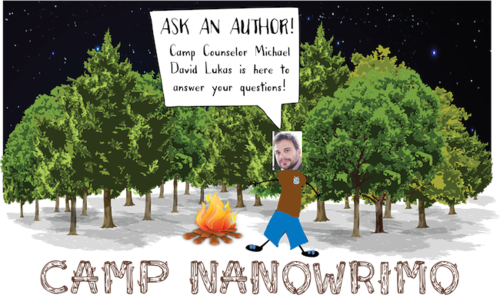
Each week, a new author will serve as your Camp Counselor, answering your writing questions. Michael David Lukas, our final counselor, is author of historical novel The Oracle of Stamboul:
How can writers steer the conflict to escalation where it’s “hitting the fan” and then wrap up the plot and subplots to an ending? — Anonymous
This is a big question. So as not to get overly vague or surpass my word limit, I’m going to focus my answer on the second half. How can we wrap up the plot and subplots?
Ending a novel can be difficult because it involves a shift in speed. For much of the novel you’ve been increasing tension, putting your foot on the gas. And then, when you begin wrapping things up you have to slow down and decrease the tension.
There are many ways to end a novel. But no matter how you decide to bring your book to a close, it’s important to make sure that you have addressed the big question(s) you set out at the beginning. Did she find the magic necklace? Did he come to terms with his brother’s betrayal? Did they defeat the aliens? Think of the ending as a chance to answer all of the remaining questions your reader might have.
It is also the place where you can impose a sense of moral order on the universe of your novel. It’s your chance to dole out rewards to your favorite characters and to punish those you don’t like. Alternately, the ending can be an opportunity to expose the utter chaos and disorder that is life (i.e. the sweet and thoughtful recent college graduate ends up getting passed over for the job she wants more than anything else in the world or the evil warlords continue to wreck havoc on the simple villagers).
Finally, I would urge you to try to avoid the Hollywood style ending that jumps from resolution to resolution. Although you want to give your readers a sense of closure and let them know where various characters ended up, they don’t need to know whether the main character’s mother’s dog succeeded in catching that bird.
Official word-count validation has begun! Make sure to claim your win (and some awesome winner goodies) by following these steps.
April 25, 2014
Ask An Author: "With all of the existing imaginary worlds out there, how do you create a world that's unique to your own story?"
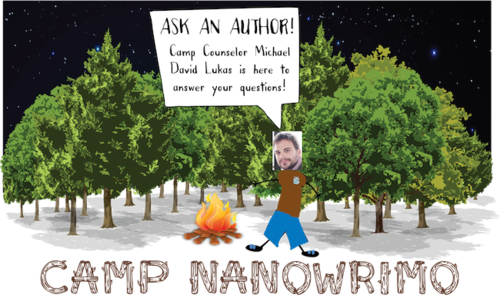
Each week, a new author will serve as your Camp Counselor, answering your writing questions. Michael David Lukas
, our final counselor, is author of historical novel The Oracle of Stamboul:
With all of the existing imaginary worlds out there, how do you create a world that’s unique to your own story? — Katie Spektor
On the surface, this seems like a question oriented towards science fiction and fantasy novels. But, in fact, it’s applicable to any genre. Novel writing is, first and foremost, world building. You may be building a world ruled by the electric sheep from android dreams or you might be building a world that looks very similar to our own. Regardless, writing a novel is about creating a landscape, populating it, setting the rules, and telling the stories that bubble up to the surface.
Whatever your world may be, it has to be one that is uniquely yours. Your world can be influenced by other fictional worlds. But in order for the world to be successful it should be one that you have created and (importantly) one that you will feel comfortable living in for the next few years.
Spend some time in your world before you start writing, give yourself the space to imagine who lives there, what the air smells like, how hard the sun beats down. Build the world out in your mind before putting it down on the page. Because once you start writing, the demands of story start to take over.
And, if at all possible, try not to think about the market (whether people want to buy a book about talking hippopotamuses or a slightly noirish remake of Garfield). Try not to let all the vampires, werewolves, and plucky dystopian heroines influence your world building. A world that’s unique to you will be more enjoyable to write about and, ultimately, it will produce a book that’s more enjoyable to read.
Official word-count validation starts today! Make sure to claim your win (and some awesome winner goodies) by following these steps.
April 24, 2014
Writer Fuel: Of All-Powerful Authors, Backwards Walkers, and the Writing Fool

Every writer needs a little writer fuel, whether it’s fueling your body, or your mind. Every week, staffers at Camp NaNoWriMo HQ will be telling you about the food and the music that inspires them. Today, executive director Grant Faulkner unpacks the power of ‘the fool’:
To get where you’re going, sometimes you’ve got to go the wrong way. You might not truly know what it feels like to stand right side up until you stand upside down. Sometimes you have to wear a costume to find out who you are.
NaNoWriMo is famous for its “just show up” approach to writing. But sometimes you’ve got to know when to not show up, or rather, when to show up in a different way. I say this because “showing up” to revise my novel during this session of Camp has felt like an exercise in rigidity of late.
My writing feels like I’m hammering a nail into a stiff board over and over again. The nail bends. I straighten it. I start hammering again. I recently asked myself, “How do I bring a sense of playfulness to this thing?”
That’s why for my writer fuel I’ve turned to “the Fool,” one of my favorite archetypal characters in literature. The Fool is not expected to “know better” or “know” anything, but he often knows things in ways the other characters don’t. He babbles, acts like a child, and doesn’t understand social conventions (or at least he pretends not to), so he’s not held culpable for breaching any rules. As a result, he can speak the truth in ways others can’t. You might say the Fool is the ultimate storyteller: he takes the conniving risks necessary to tell the tale only he can see.
The Fool has many variants in different mythologies and real life. Since I’m a basketball fan, I often think of one of my favorite players, Dennis Rodman. While many were annoyed by Rodman’s antics—his cross-dressing, his late nights of dancing with abandon—Phil Jackson, his coach with the Chicago Bulls, thought his supposed disruptions actually helped the team gel. Jackson praised Rodman because he resembled a Heyókȟa in Lakota Sioux lore. A Heyókȟa was a backwards walker, a trickster spirit. A Heyókȟa spoke, moved, and reacted in the opposite fashion as other people.
For example, if food were scarce, a Heyókȟa would complain about how full he was. During a heat wave, a Heyókȟa would shiver with cold and cover himself with a thick blanket. By doing the unexpected, the Heyókȟa asked “Why?” about sensitive topics and used satire to question those in positions of power and authority.
For the purposes of this piece, think of yourself as the all-powerful author, who’s lording a logic, a vision, and a bunch of rules over your story. We need the Fool or the Heyókȟa to keep from taking ourselves too seriously (a horrible hazard of revision). So each day when I begin writing, I ask, how would the Fool write this overly ponderous scene? How can I have a character do or say something to shock and challenge? I ask the Fool to help me not care about any taboos or novel rules. I bow to the gods of possible embarrassment.
I’ve always believed in fools. As Isaac Asimov said, “The great secret of the successful fool is that he is no fool at all.” Sometimes you have to be foolish to be wise. Sometimes you need to break the rules to find new ones. I urge you to be a little foolish in all endeavors.
— Grant Faulkner
April 23, 2014
Ask An Author: "How do you bring humor into tense scenes without making light of a serious issue?"
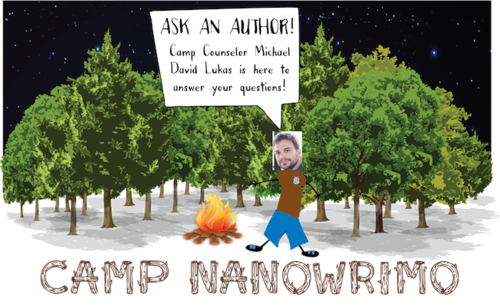
Each week, a new author will serve as your Camp Counselor, answering your writing questions. Michael David Lukas, our final counselor, previously wrote for our blog about throwing a wrench into your revision routine, and is the author of historical novel The Oracle of Stamboul.
How do you bring humor into tense scenes without making light of a serious issue? — Anonymous
Humor can be a great tool in novel writing. And, as the question implies, it can be especially useful as a way to break the ice in a scene with a lot of tension. Also, because humor relies on tension and the confounding of expectations, a middling to weak joke can pack an extra punch when delivered in a tense situation. But, before you go sprinkling jokes throughout all the serious conversations and violent confrontations in your novel, consider these three questions.
Is it funny? Seems like a no brainer, but I often hold onto a bit of humor for sentimental reasons, even if it isn’t funny. Try reading the moment aloud to a friend (or even better a stranger) to see how they react.
Does it serve the novel? Humor can move the plot forward, it can build a character’s personality, or it can relieve tension. But you want to make sure that you’re not just throwing a joke in there for no reason, even if it is funny.
Is it consistent? If your character is making a joke, does the joke (and the context of the telling) fit the character’s personality? If the humor is situational (i.e. a clumsy detective fumbling with her gun in a standoff with the villain) does the humor fit the narrative voice? If the narrative voice is usually somber and serious, a joke at a tense moment might draw the reader out of the spell you’ve cast.
Humor is a great tool. But it’s important to think about how your humorous moments fit into the larger narrative arc, character building and/or narrative voice. If you can check all these boxes, you can be pretty sure you won’t be making light of a serious situation.
Don’t miss our #AskCampNaNo tweetchat with Michael and last week’s counselor, Patricia C. Wrede, this Thursday, 4/24/14, at 4 PM PST!
Chris Baty's Blog
- Chris Baty's profile
- 63 followers




